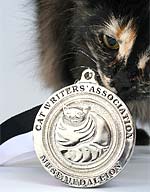 |
|||||||||||||||||||
|
|

We are the proud winners of the 2006 - 2009 winner of the Muse Medallion for Online Magazine by The Cat Writers? Association in their annual Communications Contest! (Photo courtesy of Weems Hutto).
On November 17, 2007 Felinexpress.com was honored to receive The President's Award by the Cat Writers' Association. We are very proud to have earned this distinction and will continue to provide quality information for all cat lovers.
Felinexpress.com Home > Kitten Care > Weaning Kittens |
Weaning Kittens
Kittens are adorable, that everyone can agree on. Queens give birth to one to ten kittens. Free- ranging queens get mated with more than once during a heat cycle (resulting in two or three tomcats fathering the litters). Newborn kittens are so appealing, small, and cuddly and those wide eyes once they open. But soon, the magic of the kittens starts to wears off and people start adopting out kittens at five weeks of age. But at what age do you start weaning kittens?
Kittens will wean themselves from mother (with her help) by seven weeks old. Ideally, kittens should be allowed to remain with the queen for at least five more weeks. This rarely occurs (except with ethical cat breeders). Keeping kittens with mom for an extended period of times means the owner has to over-feed the mother so she can keep up with the needs of her young. This gets expensive and adds to the owner’s desire to find homes for the kittens early.
If your kitten is being bottle-fed, watch the kitten for signs that he is ready to go off bottle. He will give you signals to go away from the bottle by crying after feeding, or being restless after eating (check to be sure the nipple on the bottle isn’t plugged). Another clue is the kitten will start chewing on the tip of the bottle or try to bite your fingers as you feed.
If the queen stays with her kittens till they are older, she teaches them how to eat solid foods, she disciplines, instructs on how to use the litter pan and how to hunt. From the time the kitten(s) are seven weeks old, the queen will begin weaning her kittens by making herself less available. The kittens protesting will follow the mother cat around suckling on her trying to get milk from mother. She will continue moving off to discourage them.
They will learn to eat solids from watching her. They get the cat food on their paws and in their faces, lick it off and catch on quickly that this is the way to be fed. If you don’t want your kittens to eat strictly a wet food diet, the mother cat will teach them how to go off of wet food over time.
If the kittens are born outside, the mother cat starts weaning her kittens earlier (about five weeks of age). This is when they learn to hunt prey. The mother will capture and kill the prey. Instead of eating it, she brings it back to the nest tossing it towards the kittens until they figure out this is dinner. In a few weeks time, she will lead the whole litter on an active “live” hunt then sit back and let the kittens take charge of the kill without joining them in the feast.
Indoor kittens learn from watching the mother what to eat and drink. This often leads to the kittens making a huge mess as they wade through their food. Putting the solid food into jar lids will help cut down the mess considerably until the kittens have mastered the art of eating. Elevate the jar lids slightly so the kitten has an easier time of eating. Meat-flavored baby food mixed with kitten formula is a good first step to take to transition kittens off mom’s milk to solids. Check the label and be certain the baby food doesn’t contain onions, garlic or salt; (these ingredients can cause Heinz Body Anemia).
Be sure to stay in the room while they are eating. Have soft rags available for wiping off mouths and noses so the kittens don’t choke. Or, buy a large flat, low-sided dish or tray to keep the kittens in one area and the food off your floor or carpet. Warm up any food you are feeding to a comfortable level. Never feed food straight out of the refrigerator! Use your finger, a straw or a plastic spoon to place the food into the kitten’s mouth until the kitten catches on and starts eating. Then place the kitten into a clean litter pan full of plain, clay litter.
Over the next week or so, start adding in kitten chow, or canned kitten food until the kitten has made the full transition over to the solid food. If at any time during the weaning process, your kitten(s) develop diarrhea stop transitioning into other foods until the loose stool stops.
Weaning kittens at a later age allows for an easier transition to solid or dry food. When you wean them should be decided on their cues. The kitten formula and even mother’s milk isn’t satisfying after about seven weeks. Their bodies are growing rapidly. Different food is needed to keep up with their needs.
More cat breeds |
|
? Copyright 2006-2010 Felinexpress.com, All Rights Reserved
Privacy Statement - Disclaimer - About Me


